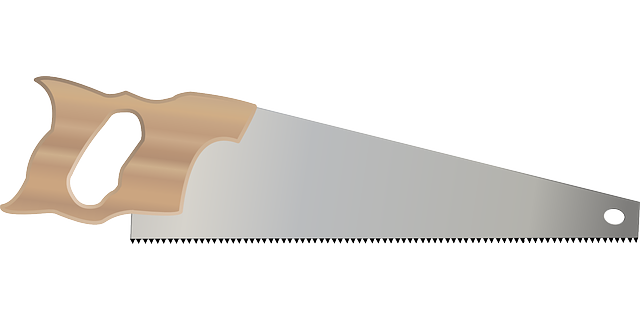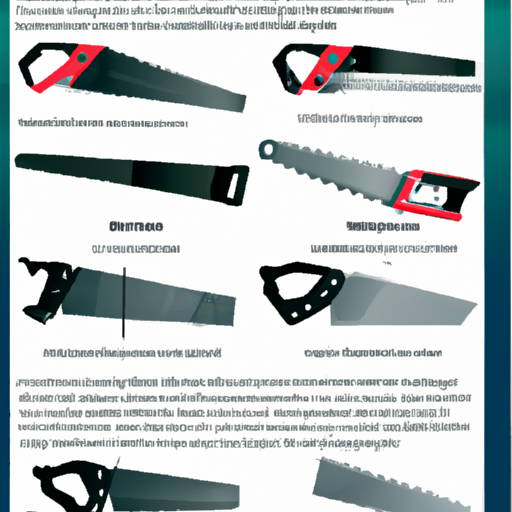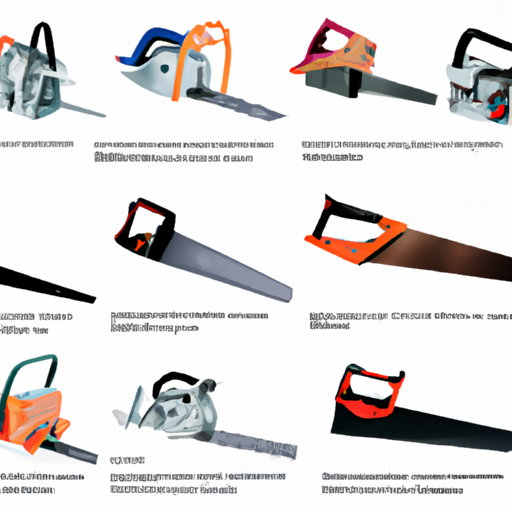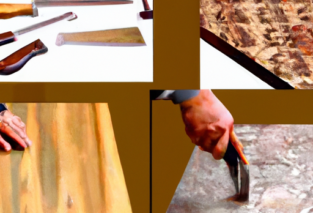In this article, you’ll learn all about selecting the ideal saw for various cutting tasks. We’ll explore different types of saws and their specific uses, guiding you through the decision-making process. By the end, you’ll have a better understanding of which saw to choose for your specific needs, making your cutting tasks a breeze! When it comes to tackling various cutting tasks, having the right type of saw is essential. With so many saw options available, it can be overwhelming to determine which one will best suit your specific needs. This article will guide you through the process of understanding different types of saws, considering factors for choosing the right saw, determining your cutting needs, selecting the right saw for specific tasks, comparing different brands and models, seeking expert advice, demoing and trying out saws before purchasing, and maintaining and caring for your saw. By following these steps, you’ll be on your way to making informed decisions and achieving successful cutting tasks.

Understanding Different Types of Saws
Hand Saws
Hand saws are the most traditional and basic type of saw. They are operated manually and have a handle at one end and a blade with sharp teeth on the other. Hand saws are commonly used for cutting through wood, but they can also handle other materials such as plastic and metal. These saws are versatile, easy to use, and suitable for simple cutting tasks.
Circular Saws
Circular saws are power tools that feature a circular blade with teeth around the edge. They are excellent for making straight cuts through various materials, including wood, metal, and plastic. Circular saws are popular among DIY enthusiasts and professionals due to their versatility and ability to tackle different cutting tasks.
Jigsaw
If you need to make curved or intricate cuts, a jigsaw is the ideal tool for the job. Jigsaws have a thin, reciprocating blade that moves up and down rapidly. This allows for precise and detailed cuts in various materials, such as wood, metal, and plastic. With the ability to change blades for different cutting purposes, a jigsaw offers flexibility for creative and complex cutting tasks.
Miter Saws
Miter saws, also known as chop saws, are designed to make accurate angled cuts. They have a fixed arm that allows the blade to pivot and tilt in different directions. Miter saws are commonly used for cutting materials at precise angles, making them perfect for tasks like crown molding, picture frames, and woodworking projects that require angled cuts.
Reciprocating Saws
Reciprocating saws, often referred to as “sawszalls,” are designed for demolition work and rough cuts. They have a blade that moves in a back-and-forth, sawing motion, making them ideal for cutting through materials like drywall, pipes, and tree branches. Reciprocating saws are powerful and versatile tools that can handle a wide range of cutting tasks.
Table Saws
Table saws are heavy-duty tools commonly used in woodworking. They feature a circular blade mounted on an adjustable table, which allows for precise and accurate cuts. Table saws are ideal for large woodworking projects that require straight and rip cuts. They can handle various types of wood and other materials with ease.
Understanding the different types of saws is crucial in choosing the right one for your cutting tasks. Now, let’s dive into the considerations you should keep in mind when selecting a saw.
Considerations for Choosing the Right Saw
Type of Material to be Cut
Different saws excel at cutting specific materials. Consider what type of material you’ll primarily be working with to determine the best saw for the job. For example, if you’ll be mainly cutting through wood, a circular saw or table saw would be suitable. If you’ll be cutting through metal or plastic, a saw with a high-speed blade designed for those materials would be more appropriate.
Cutting Technique
Consider your preferred cutting technique. Are you comfortable using a hand saw or do you prefer the speed and precision of a power tool? Different cutting techniques require different types of saws. For example, if you prefer manual control, a hand saw or jigsaw would be suitable. If you prefer speed and efficiency, a circular saw or reciprocating saw would be a better choice.
Accuracy and Precision
If accuracy and precision are essential for your cutting tasks, look for saws that offer features like laser guides or built-in measuring systems. Miter saws, for example, are known for their precise angled cuts, making them a great choice for tasks that require precision and accuracy.
Portability and Ease of Use
Consider the portability and ease of use of the saw. If you’ll be working on different job sites or need to move the saw around frequently, opt for a lightweight and portable saw. Circular saws and jigsaws are generally more portable compared to table saws or miter saws.
Safety Features
Always prioritize safety. Look for saws with safety features such as blade guards, blade brakes, and ergonomic handles. These features will help minimize the risk of accidents and ensure your safety during cutting tasks.
Taking these considerations into account will help narrow down your options and guide you towards choosing the right saw for your cutting needs. So, how do you determine your specific cutting needs?
Determining Your Cutting Needs
General Purpose Cutting
If you’ll be performing general-purpose cutting tasks, such as cutting through basic lumber or plywood, a circular saw or a hand saw may be sufficient. These saws are versatile and can handle a wide range of materials and cutting depths.
Precision Cutting
When precision and accuracy are critical, a miter saw is the ideal choice. Miter saws allow you to make angled cuts with precision and consistency, making them perfect for tasks like crown molding or picture framing.
Curved Cuts
For cutting curves or intricate shapes, a jigsaw is the go-to tool. Jigsaws offer excellent maneuverability and control, allowing you to make precise curved cuts in various materials.
Miter Cuts
If your cutting tasks involve making angled cuts, such as mitered corners or joints, a miter saw is the best option. With its ability to pivot and tilt the blade, a miter saw ensures precise cuts at specific angles.
Rip Cuts
If your projects mainly involve ripping large panels or boards, a table saw is the most efficient choice. Table saws provide stability, accuracy, and the power needed for making long, straight cuts.
Cross Cuts
For cutting across the grain or making perpendicular cuts, a circular saw or table saw can get the job done. Both saws provide the necessary power and ability to make accurate cross cuts.
Understanding your specific cutting needs will help you narrow down your choices and ensure you select the right saw for the job at hand. With your cutting needs determined, let’s explore the different types of saws and select the most appropriate one for specific tasks.
Selecting the Right Saw for Specific Cutting Tasks
Choosing a Hand Saw for Simple Cuts
For simple and occasional cutting tasks, a hand saw is a reliable choice. Hand saws are easy to use, portable, and suitable for cutting through various materials. Whether you need to trim a small piece of wood, cut a plastic pipe, or make minor adjustments, a hand saw will get the job done.
Opting for Circular Saws for Versatility
Circular saws are versatile and can handle a wide variety of materials and cutting tasks. With the ability to change blades for different purposes, a circular saw can make both straight and beveled cuts. Whether you’re working on woodworking projects, DIY home improvements, or construction tasks, a circular saw is a valuable tool to have in your arsenal.
Using a Jigsaw for Curved or Intricate Cuts
When it comes to cutting curves or intricate shapes, a jigsaw is the best tool for the job. Its reciprocating blade allows for precise and maneuverable cuts. Jigsaws are commonly used for tasks such as cutting out intricate designs, making curved cuts in countertops, or creating openings in drywall.
Miter Saws for Angled and Precision Cuts
If your cutting tasks involve making precise angled cuts, a miter saw is a perfect choice. Miter saws excel at making accurate crosscuts, miter cuts, bevel cuts, and compound cuts. Whether you’re working on crown molding, baseboards, or picture frames, a miter saw will ensure precise, professional-looking cuts.
Reciprocating Saws for Demolition and Rough Cuts
When it comes to demolition work or rough cuts, a reciprocating saw is your best bet. These powerful saws can handle tough materials like wood, metal, and plastic. Whether you’re tearing down a wall, pruning trees, or cutting through pipes, a reciprocating saw will get the job done quickly and efficiently.
Table Saws for Large Woodworking Projects
If you’re embarking on large woodworking projects that require long, straight cuts, a table saw is a must-have. Table saws provide stability, accuracy, and the power needed for making rip cuts and crosscuts in large pieces of wood. Whether you’re building furniture, cabinets, or decking, a table saw will be your workhorse.
Selecting the right saw for specific cutting tasks will ensure efficiency, accuracy, and successful completion of your projects. However, there are a few additional factors to consider before making a final decision.

Factors to Consider when Making a Decision
Budget
Consider your budget when choosing a saw. Different saws come at various price points, so it’s essential to find one that fits your budget without compromising on quality and functionality.
Experience and Skill Level
Think about your experience and skill level as a saw user. Some saws may require more skill and experience to operate effectively. If you’re a beginner, opt for saws that are user-friendly and easy to handle.
Availability of Power Source
Consider the availability of a power source in your workspace. Some saws require electrical outlets, while others may run on batteries or have a gasoline-powered engine. Choose a saw that aligns with the available power source in your working environment.
Workspace and Storage
Evaluate your workspace and storage capacity. If you have limited space, consider more compact and portable saw options that are easy to store. Think about how your saw will fit into your workspace and make sure you have adequate room for comfortable operation.
Future Cutting Projects
Anticipate your future cutting projects and consider whether the saw you’re planning to purchase will meet your long-term needs. Investing in a saw that can handle a wide range of cutting tasks will save you money and time in the future.
Taking these factors into account will help you make an informed decision and choose the right saw that suits your specific requirements. However, it’s always beneficial to research and compare different brands and models before making a final purchase.
Comparing Different Brands and Models
Researching Trusted Brands
Do your research on different brands that are known for manufacturing quality saws. Look for brands that have a reputation for durability, reliability, and customer satisfaction. Read up on their manufacturing processes, materials used, and the quality control measures they employ.
Reading Reviews and Ratings
Customer reviews and ratings provide valuable insights into the performance, reliability, and overall satisfaction of saws. Seek out reviews from trusted sources or websites that specialize in tool reviews. Reading feedback from other users who have used the saws you’re interested in will give you a better understanding of their pros and cons.
Considering Features and Specifications
Compare the features and specifications of different saw models. Look for features that align with your specific cutting tasks and requirements. Consider factors such as the power output, cutting capacity, blade size, and safety features. Comparing different models side by side will help you determine which saw offers the best combination of features for your needs.
Taking the time to research, read reviews, and compare different saw brands and models will ensure that you invest in a high-quality tool that will serve you well for years to come. However, expert advice and recommendations can further enhance your decision-making process.

Seeking Expert Advice and Recommendations
Consulting with Professionals or Experienced Users
Reach out to professionals or experienced users who have extensive knowledge and hands-on experience with different saws. Seek their advice and recommendations based on your specific cutting needs and projects. They can provide valuable insights and help you make an informed decision.
Visiting Hardware or Woodworking Stores
Visit your local hardware or woodworking stores and speak with the knowledgeable staff. They can guide you through the specific features and capabilities of different saws, allowing you to ask questions and handle the saws in person. Their expertise will assist you in selecting the right saw for your needs.
Joining Online Forums or Community Groups
Join online forums or community groups focused on DIY, woodworking, or construction. Engage with fellow enthusiasts and professionals to gather their personal experiences and recommendations. Online communities are a great source of information, and members are often more than willing to share their expertise and insights.
Seeking expert advice and recommendations will complement your research and provide you with a well-rounded understanding of the saws you’re considering. However, it’s essential to demo and try out different saws before making a final purchase.
Demo and Try Before Purchasing
Renting or Borrowing Different Saws
Consider renting or borrowing saws from friends, family members, or tool rental stores. This will give you the opportunity to test different saws and evaluate their performance firsthand. By using the saws for your specific cutting tasks, you can determine which ones are most comfortable and effective for you.
Testing Their Performance and Handling
When demoing different saws, pay attention to their performance and handling. Take note of their power, ease of use, precision, and comfort. Consider the weight, ergonomics, and overall feel of the saw in your hands. This hands-on experience will help you make an informed decision based on your personal preferences and needs.
Making an Informed Decision
After demoing and testing different saws, you’ll be able to make an informed decision based on your firsthand experience. Take into account how each saw performed, how comfortable it was to use, and which one felt like the best fit for your specific cutting tasks. Making the effort to try out different saws before purchasing will greatly increase your satisfaction with your final choice.
Once you’ve made your purchase, it’s important to properly maintain and care for your saw to ensure its longevity and optimal performance.

Maintenance and Care for Longevity
Cleaning and Lubricating the Saw
Regularly clean and lubricate your saw to prevent dust, debris, and rust buildup. Wipe down the saw after each use and use a brush to remove any sawdust or debris from the blade and other moving parts. Applying a lubricant to the blade and other metal components will reduce friction and prolong the life of your saw.
Replacing or Sharpening Blades
Keep an eye on the sharpness of your saw blades. Dull blades can compromise the quality of your cuts and put unnecessary strain on the saw. Replace or sharpen blades as needed to ensure optimal cutting performance. Follow the manufacturer’s instructions for blade replacement or sharpening to ensure safety and accuracy.
Storing in a Dry and Safe Area
Proper storage is essential for maintaining the longevity of your saw. Store your saw in a dry area to prevent rust and corrosion. Ensure that it is protected from moisture and extreme temperatures. Use a dedicated storage space, such as a toolbox or wall mount, to keep your saw organized and easily accessible.
By following these maintenance and care guidelines, you’ll be able to extend the lifespan of your saw and ensure its optimal performance throughout its lifetime.
Conclusion
Choosing the right type of saw for different cutting tasks is crucial. By considering factors such as the type of material to be cut, cutting technique, accuracy and precision requirements, portability, safety features, and your specific cutting needs, you can narrow down your options and select the most suitable saw.
Researching and comparing different brands and models, seeking expert advice and recommendations, demoing and testing different saws, and properly maintaining and caring for your saw will further enhance your decision-making process and ensure the longevity of your tool.
With the right saw in your hands, you’ll be able to tackle various cutting tasks with confidence and achieve exceptional results. So, take the time to understand your needs, explore your options, and make an informed decision. Happy cutting!






